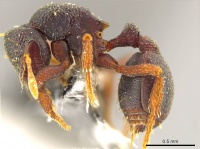Octostruma triquetrilabrum
| Octostruma triquetrilabrum | |
|---|---|

| |
| Scientific classification | |
| Kingdom: | Animalia |
| Phylum: | Arthropoda |
| Class: | Insecta |
| Order: | Hymenoptera |
| Family: | Formicidae |
| Subfamily: | Myrmicinae |
| Tribe: | Attini |
| Genus: | Octostruma |
| Species: | O. triquetrilabrum |
| Binomial name | |
| Octostruma triquetrilabrum Longino, 2013 | |
Octostruma triquetrilabrum is known from two sites near Monteverde in the Cordillera de Tilarán, and one site in the mountains of western Panama. One Monteverde site is very wet, old-growth montane forest at 800 m on the Atlantic slope, and the other Monteverde site is a small patch of seasonal moist forest at 1150 m, just below the cloud forest on the Pacific slope. All specimens are from Winkler samples of sifted leaf litter. (Longino 2013)
Identification
With the characters of Octostruma wheeleri and Octostruma triangulabrum. Differing from O. wheeleri in the presence of 8-10 spatulate setae on face (6 on O. wheeleri) and shallow reticulate rugulose sculpture on face and dorsal pronotum (nearly smooth on O. wheeleri). Differing from O. triangulabrum in the absence of a pair of spatulate setae on the mesonotum (present in O. triangulabrum); first gastral sternite more uniformly punctate. (Longino 2013)
Keys including this Species
Distribution
Latitudinal Distribution Pattern
Latitudinal Range: 10.31667° to 8.783333333°.
| North Temperate |
North Subtropical |
Tropical | South Subtropical |
South Temperate |
- Source: AntMaps
Distribution based on Regional Taxon Lists
Neotropical Region: Costa Rica (type locality), Panama.
Distribution based on AntMaps
Distribution based on AntWeb specimens
Check data from AntWeb
Countries Occupied
| Number of countries occupied by this species based on AntWiki Regional Taxon Lists. In general, fewer countries occupied indicates a narrower range, while more countries indicates a more widespread species. |

|
Estimated Abundance
| Relative abundance based on number of AntMaps records per species (this species within the purple bar). Fewer records (to the left) indicates a less abundant/encountered species while more records (to the right) indicates more abundant/encountered species. |

|
Biology
|
Castes
Known only from the worker caste.
Nomenclature
The following information is derived from Barry Bolton's Online Catalogue of the Ants of the World.
- triquetrilabrum. Octostruma triquetrilabrum Longino, 2013: 53, figs. 1A, 3A, 5K, 39, 43 (w.) COSTA RICA.
Unless otherwise noted the text for the remainder of this section is reported from the publication that includes the original description.
Description
Worker
HW 0.74–0.80, HL 0.68–0.72, WL 0.84–0.88, CI 109–111 (n=2). Matching in almost every respect the description for Octostruma triangulabrum, except the differences outlined in the Diagnosis and key.
Type Material
Holotype worker: COSTA RICA, Puntarenas: Est. Biol. Los Llanos, near Santa Elena, 10.30487, -84.83735, ±100 m, 1150 m, 28 Feb 2004, moist forest, ex sifted leaf litter (J. Longino#5249-s) Instituto Nacional de Biodiversidad, JTLC000004551. Paratype workers: same data John T. Longino Collection, JTLC000004543; same data except Alajuela: Casa Eladio, Rio Peñas Blancas, 10.31667, -84.71667, ±2 km, 800 m, 10 May 1989, wet forest, ex sifted leaf litter on ground (J. Longino#2529-s) California Academy of Sciences, INBIOCRI001281407; 23 May 1990 (J. Longino#2701-s) National Museum of Natural History, CASENT0627377; Museum of Comparative Zoology, CASENT0627378; University of California, Davis, INBIOCRI001282521; Museu de Zoologia da Universidade de Sao Paulo, INBIOCRI001282522; CASC, INBIOCRI001282523.
Etymology
The name refers to the triangular labrum that is not bilobed at the apex. It is a noun in apposition and thus invariant.
References
- Longino, J.T. 2013. A revision of the ant genus Octostruma Forel 1912 (Hymenoptera, Formicidae). Zootaxa 3699, 1-61. doi:10.11646/zootaxa.3699.1.1
References based on Global Ant Biodiversity Informatics
- Longino J. T. 2013. A revision of the ant genus Octostruma Forel 1912 (Hymenoptera, Formicidae). Zootaxa 3699(1): 1-61.
- Ulyssea M. A., L. P. Prado, C. R. F. Brandao. 2015. Type specimens of the traditional Myrmicinae (Hymenoptera: Formicidae) ant tribes deposited in the Museu de Zoologia da Universidade de Sao Paulo, Brazil: Adelomyrmecini, Basicerotini, Blepharidattini, Crematogastrini, Formicoxenini, Lenomyrmecini, Myrmicini, Phalacromyrmecini, Pheidolini, Stegomyrmecini, Stenammini and Tetramoriini. Papeis Avulsos de Zoologia, Museu de Zoologia da Universidade de Sao Paulo 55(12): 175-204.


